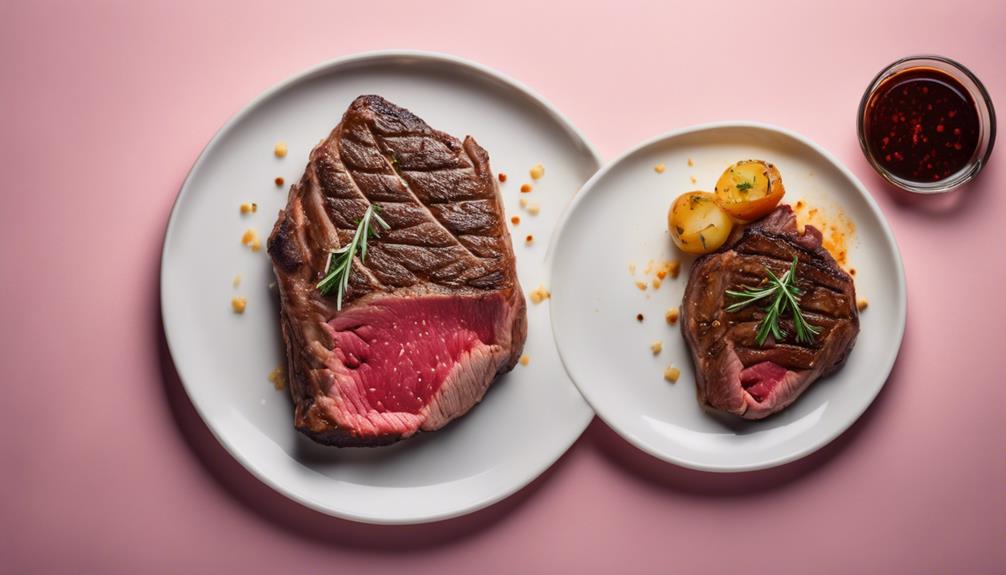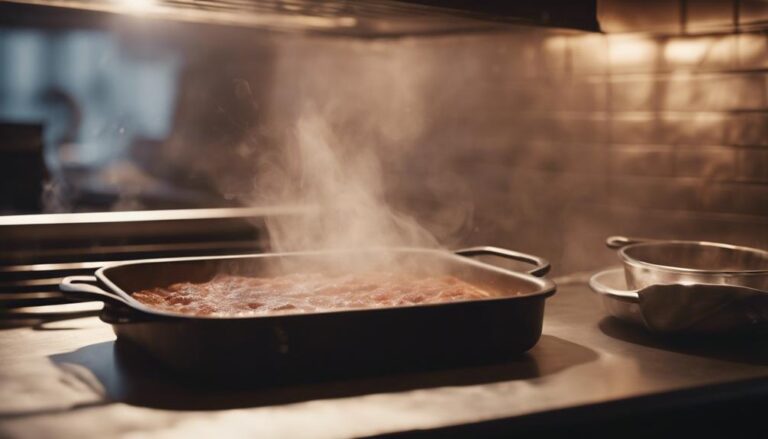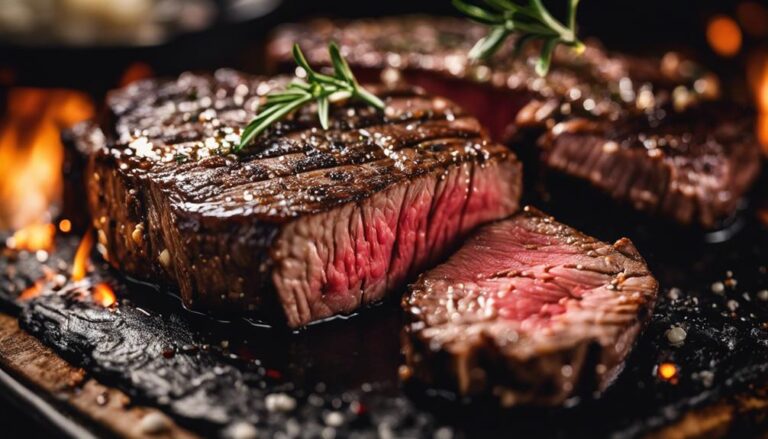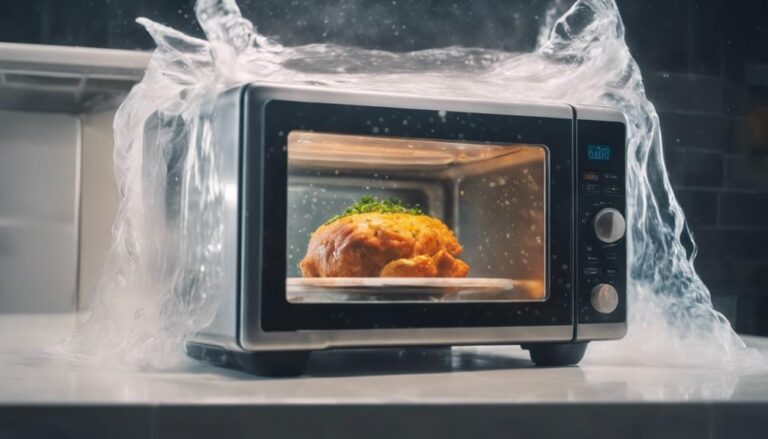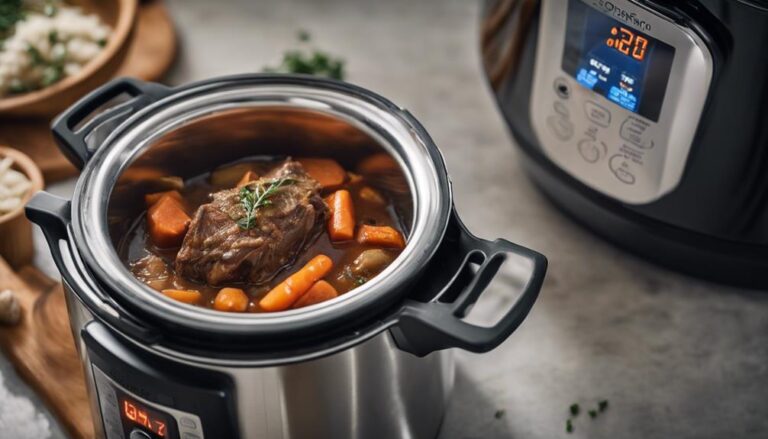Sous Vide Vs Pan-Frying: Taste Comparison Guide
When deciding between sous vide and pan-frying, it's about texture and flavor. Pan-frying makes crispy outsides with rich flavors quickly. But sous vide keeps food tender with natural juices preserved. Do you prefer a crunchy coating or a succulent, evenly cooked interior? Both techniques have unique benefits for a delicious outcome. If you want to choose the best method for your dish, consider how each one can enhance your culinary experience.
What You Will Learn Here
- Sous vide preserves natural flavors for a pure taste experience.
- Pan-frying enhances flavors with rich caramelization and Maillard reaction.
- Sous vide offers tender, juicy results with minimal flavor alteration.
- Pan-frying delivers a crispy, golden exterior for added texture and taste.
- Choosing between methods depends on desired texture and flavor preferences.
Crispy Exterior Vs. Tender Interior
When comparing the crispy exterior achieved through pan-frying with the tender interior from sous vide cooking, the contrast in textures becomes evident. Pan-frying allows the food to develop a delightful crunchy outer layer due to direct contact with the hot pan. This method triggers the Maillard reaction, enhancing both flavor and texture.
On the other hand, sous vide cooking involves sealing the food in a bag and immersing it in a precisely controlled water bath. This gentle cooking process guarantees that the interior of the food remains beautifully tender, as it cooks evenly at a consistent temperature.
Imagine serving a perfectly seared steak with a crispy, caramelized crust from pan-frying, while the inside remains incredibly juicy and tender from sous vide cooking. The combination of these two techniques can elevate your dish to new heights, offering a harmonious blend of textures and flavors that will surely impress those you serve.
Whether it's a succulent piece of meat or a delicate vegetable, mastering the balance between a crispy exterior and a tender interior will take your culinary skills to the next level.
Quick Cooking Vs. Controlled Temperature
When deciding between quick cooking and controlled temperature methods, you'll need to weigh the trade-off between speed and precision. Pan-frying offers high heat for a rapid cooking process, resulting in crispy exteriors, whereas sous vide provides a controlled temperature environment for more precise cooking outcomes.
It's a choice between fast browning with pan-frying or even cooking throughout with sous vide's constant temperature.
Speed Vs Precision
Choosing between speed and precision in cooking can greatly impact the overall outcome of your dish when comparing pan-frying and sous vide methods. Pan-frying offers quick cooking speed, providing immediate results for time-sensitive meals. On the other hand, sous vide guarantees controlled temperature precision, resulting in consistent and evenly cooked dishes every time. Pan-frying requires active monitoring and quick decision-making during the cooking process, while sous vide allows for a set-it-and-forget-it approach, perfect for multitasking or preparing in advance. The choice between speed and precision ultimately depends on the desired outcome of your dish. Here's a comparison table to help you understand the differences better:
| Aspect | Pan-Frying | Sous Vide |
|---|---|---|
| Cooking Speed | Quick | Slow and Controlled |
| Monitoring | Active monitoring required | Set-it-and-forget-it |
| Outcome | Crispy exteriors | Tender and juicy interiors |
High Heat Vs Low-Temp
If you're aiming for quick cooking with high heat or controlled temperature for your dish, the contrast between pan-frying and sous vide methods becomes evident. Pan-frying utilizes high heat to swiftly sear the exterior of food, resulting in a crispy texture and rich flavor from browning.
On the other hand, sous vide employs low temperatures for an extended period, ensuring precise and uniform cooking, preserving the natural juices and tenderness of ingredients without the risk of overcooking. The taste comparison between pan-frying and sous vide highlights the difference between a golden, crispy surface achieved through high heat in pan-frying and a flawlessly cooked, tender interior characteristic of low-temperature sous vide cooking.
Both methods offer distinct advantages based on your desired outcome.
Caramelization and Maillard Reactions

To enhance the flavor of your dishes, understanding the differences between caramelization and Maillard reaction is crucial. Here's why:
- Caramelization: This process occurs when sugars break down and brown, providing a sweet and complex flavor to your food. When pan-frying, the direct contact with the hot surface triggers caramelization in ingredients like onions or sugar-coated proteins.
- Maillard Reaction: The Maillard reaction is a chemical interaction between amino acids and reducing sugars, resulting in savory and browned flavors. When pan-frying meat, this reaction is responsible for the delicious crust that forms on the surface.
- Impact on Taste Profiles: Caramelization primarily affects sugars, while the Maillard reaction targets proteins. By understanding these reactions, you can tailor your cooking method, whether it's sous vide for precise control or pan-frying for a quick sear, to achieve the desired flavor profile in your dishes. Both reactions play a crucial role in enhancing the overall taste and aroma of your culinary creations.
Retaining Moisture and Flavors
When it comes to retaining moisture and flavors in your food, sous vide cooking excels by sealing in up to 98% of the natural juices and tastes.
In contrast, pan-frying can strip away moisture and lead to less intense flavors due to high temperatures and oil exposure.
Sous vide's gentle cooking method guarantees that your dishes stay succulent and bursting with original flavors.
Moisture Retention Methods
Enhancing moisture retention in sous vide cooking can be achieved through various methods such as vacuum sealing ingredients and incorporating marinades or brines. To retain moisture and flavors effectively, consider the following:
- Vacuum Sealing: Use vacuum-sealed bags to lock in juices and prevent moisture loss during the sous vide process.
- Marinades and Brines: Preparing ingredients with flavorful marinades or brines before cooking can enhance moisture retention and add depth to the taste.
- Airtight Sealing: Ensuring a tight seal on the sous vide bags helps maintain the natural juices and flavors of the ingredients throughout the cooking process.
Flavor Preservation Techniques
For ideal flavor preservation techniques in cooking, focus on retaining both moisture and flavors to elevate the taste of your dish. When comparing sous vide and pan-frying as cooking methods, sous vide stands out for its exceptional flavor preservation capabilities.
With sous vide, up to 90% of the flavors and juices in the ingredients are retained, ensuring a succulent and flavorful outcome. Vacuum-sealing in sous vide prevents flavor dilution and enhances the natural taste of the food, making it a preferred method for preserving the delicate flavors of ingredients.
On the other hand, pan-frying, while quick and convenient, can lead to moisture loss and flavor changes due to the high heat and direct contact with oil. Consider these factors when choosing the best flavor preservation technique for your culinary creations.
Rich Flavor Profile Vs. Even Cooking
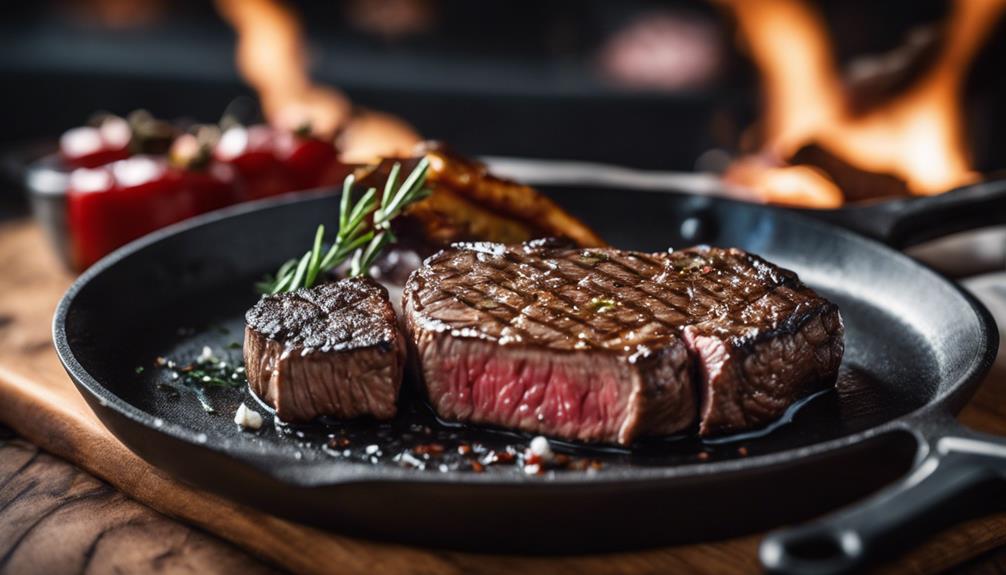
While pan-frying achieves a rich flavor profile through caramelization and Maillard reaction, sous vide guarantees even cooking with precise temperature control throughout the ingredients. When considering the taste comparison between these cooking methods, you'll find that:
- Pan-frying excels at creating a crispy texture and deep flavors due to direct contact with the pan, resulting in a darker color and intense flavor development compared to sous vide.
- Sous vide assures that your dishes are tender, juicy, and consistently cooked to perfection, making it ideal for achieving precise doneness levels.
- Both techniques offer unique benefits: pan-frying provides rich flavors and crispy textures, while sous vide delivers evenly cooked dishes with a focus on maintaining the ingredients' natural juices and tenderness.
Whether you prioritize a rich flavor profile achieved through traditional cooking methods like pan-frying or value the precise control and even cooking of sous vide, understanding the nuances of each technique will help you serve up delicious dishes tailored to your preferences.
Merits of Pan-Frying and Sous Vide
Moving on from the discussion on rich flavor profiles and even cooking, let's now explore the merits of both pan-frying and sous vide cooking methods.
Pan-frying excels in creating a crispy exterior with a beautiful golden brown color, thanks to the Maillard reaction that occurs at higher temperatures. On the other hand, sous vide cooking stands out for preserving the natural juices and flavors of ingredients, resulting in a tender and succulent texture that's hard to achieve through other cooking methods.
While pan-frying requires higher temperatures for that satisfying crunch, sous vide maintains a precise and controlled cooking environment throughout. Combining both methods, such as sous vide followed by pan-frying, can produce a perfect harmony of tenderness and crispy textures, especially when preparing dishes like chicken or steak.
Pan-frying offers a quicker cooking process with visible browning, while sous vide provides a slower and more gentle approach for precise outcomes.
Personal Preference and Desired Outcomes
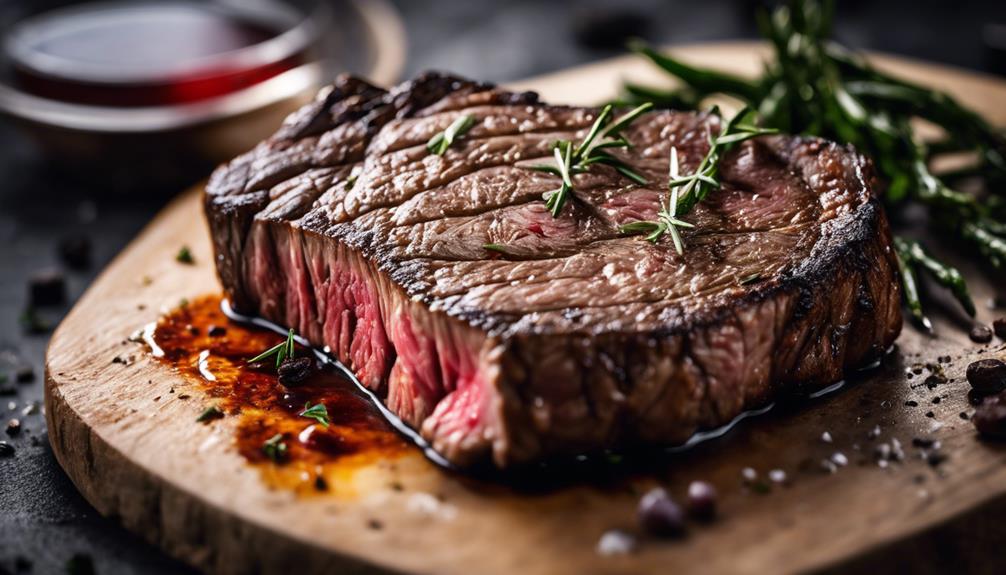
When considering your personal preference and desired outcomes in cooking, the choice between sous vide and pan-frying becomes essential. Here are some key points to keep in mind:
- Texture Preferences: Sous vide results in a more tender and evenly cooked interior, ideal for those who prefer a moist and succulent texture. On the other hand, pan-frying offers a crispy exterior with a darker color, appealing to individuals who enjoy a crunchy coating.
- Flavor Profiles: Sous vide cooking method tends to preserve the natural flavors of the ingredients, making it suitable for those who appreciate the pure taste of the food. In contrast, pan-frying can enhance flavors through caramelization and the Maillard reaction, appealing to individuals who enjoy depth and richness in taste.
- Time and Effort Consideration: The decision between sous vide and pan-frying can also be influenced by the time and effort you're willing to invest in the cooking process. Sous vide often requires longer cooking times but involves minimal hands-on effort, whereas pan-frying is quicker but demands more attention during the cooking process.
Making the Choice Between Methods
To decide between sous vide and pan-frying methods, consider your desired outcomes and cooking preferences.
If you crave a crispy finish, pan-frying is the way to go, while sous vide will deliver tender, juicy meats.
If time is of the essence, pan-frying is quicker, but if you seek precision, sous vide requires longer cooking times.
Flavor infusion is crucial – sous vide allows for precise seasoning, while pan-frying enhances flavors through the Maillard reaction.
Convenience is essential; pan-frying demands stovetop monitoring, while sous vide offers a set-it-and-forget-it approach.
Additionally, think about the equipment needed: pan-frying only requires a pan and oil, whereas sous vide necessitates a water bath and vacuum sealer.
Frequently Asked Questions
Does Sous Vide Taste Different?
Yes, sous vide does taste different. The flavor profile is enhanced, texture is tender, and moisture is retained. Sous vide benefits include precise cooking control. You'll notice the difference and likely prefer its tenderness and flavor.
Does Meat Get More Tender the Longer You Sous Vide?
Yes, meat becomes more tender the longer you sous vide. Extended cooking times break down collagen in tough cuts, resulting in juicy texture. Sous vide benefits from precise techniques, dispelling myths, and offering tips for succulent outcomes.
What Is the Difference Between Sous Vide and Regular Cooking?
When comparing sous vide to regular cooking, you'll notice distinct differences in cooking techniques, precise temperature control, texture comparison, and flavor retention. Sous vide emphasizes gentle cooking for tenderness, while pan-frying focuses on high heat for crispiness.
Why Is Sous Vide Tough?
When sous vide dishes turn out tough, it's usually due to prolonged cooking times or inaccurate temperatures. To maintain tenderness, focus on precise cooking techniques and equipment upkeep. Don't fall for misconceptions; sous vide should deliver juicy perfection.
Conclusion
In the end, whether you choose to pan-fry or sous vide your food, the decision ultimately comes down to personal preference and desired outcomes.
Pan-frying offers a crispy exterior and quick cooking, while sous vide provides a tender interior and controlled temperature.
Both methods have their merits, so experiment with both to see which one suits your tastes best.
Happy cooking!
